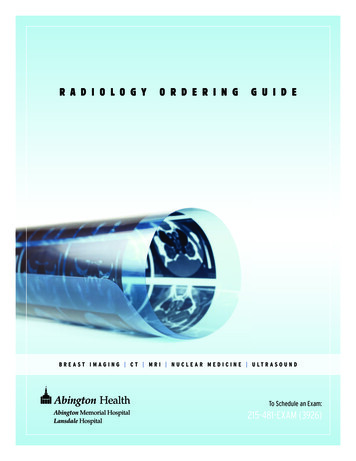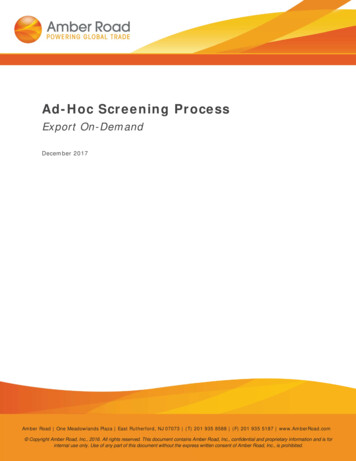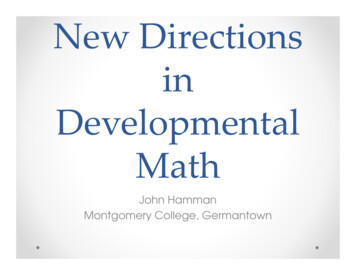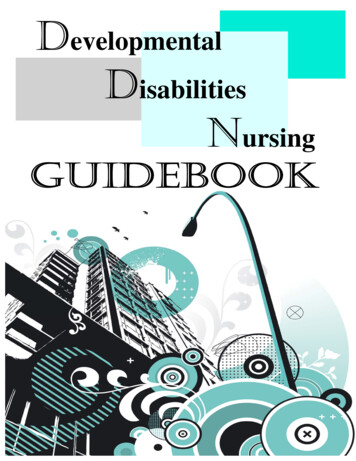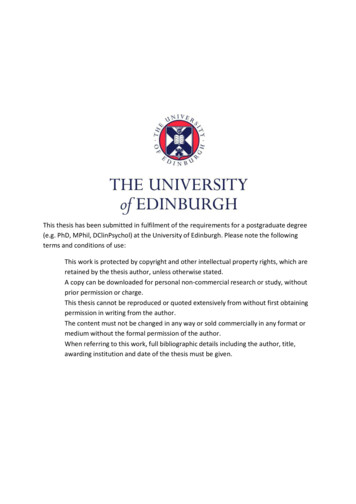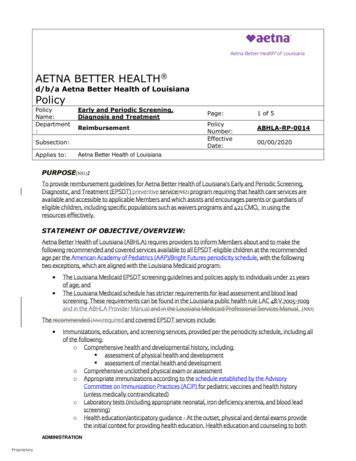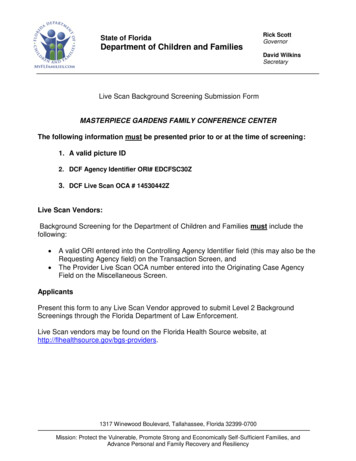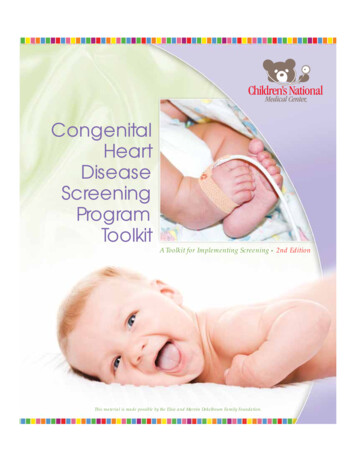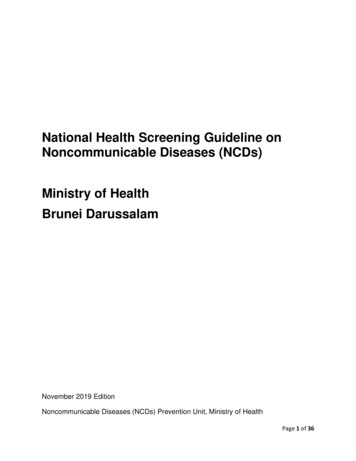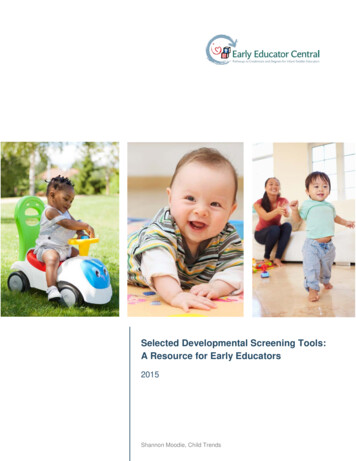
Transcription
Selected Developmental Screening Tools:A Resource for Early Educators2015Shannon Moodie, Child Trends
ContentsIntroduction .1Summary Table .3Profiles of Developmental Screeners .Ages and Stages Questionnaire—3rd Edition .7Ages and Stages Questionnaire—Social-Emotional, 2nd Edition . 12Battelle Developmental Inventory Screening Test—2nd Edition . 16Bayley III Screening Test.21Brigance Screens III .25Developmental Assessment of Young Children—2nd Edition . 29Developmental Indicators for the Assessment of Early Learning—4thEdition . 33Early Screening Inventory—Revised.37Early Screening Profiles. 42FirstSTEp Screening Test for Evaluating Preschoolers . 46Learning Accomplishment Profile—Diagnostic Screens . 50Parents’ Evaluation of Developmental Status Tools .55About the Author .58Note: This paper was created through Early Educator Central, a web portal federally administered by theU.S. Department of Health and Human Services, Office of Child Care and Office of Head Start, inresponse to the need for relevant resources to enhance infant-toddler content and coursework. ICFserved as the contractor under Contract #HHSP23320095636WC HHSP2337034T with the Departmentof Health and Human Services. The views expressed in the document are those of the author and ICF.No official endorsement by the U.S. Department of Health and Human Services is intended or should beinferred.S E L E C T E D D E V E L O P M E N T AL S C R E E N I N G T O O L SI
IntroductionChildren are varied in their physical, social-emotional, language and communication, and cognitiveskills, as well as in their approaches to learning. Some children may not clearly fit within the rangeof typical developmental patterns. Instead, they develop more slowly or develop differently fromtheir peers in both obvious and subtle ways. Developmental screeners are used to determine ifsensory, behavioral, and/or developmental skills are progressing as expected, or if there arecauses for concern. Screeners are different from early childhood formative assessments, which aredesigned to inform classroom instruction decisions. The purpose of early childhood developmentalscreening is to quickly and efficiently determine whether a child should receive a more thorough,comprehensive evaluation to identify potential difficulties that might necessitate interventions orspecial education services. 1Early educators should be aware of several important considerations regarding developmentalscreenings: Screenings are designed to be brief (30 minutes or less).Screenings cannot capture the full range of development, skill, or capacity among children.Screenings are designed to identify risk or potential developmental issues. This means thatthey tend to focus on distinguishing developmental skills and abilities in the lower range ofperformance and are not useful for capturing skills and abilities in the higher range ofperformance.Screening only indicates the possible presence of developmental delay or difference andcannot definitively identify or describe the nature or extent of a disability.Screening must be followed by a more comprehensive and formal evaluation in order toconfirm or disconfirm any red flags raised by the screening process.The developmental screeners profiled on Early Educator Central were selected because they meetthe following criteria: The tool was designed for the purpose of screening (not child assessment).The screening tool is appropriate for use with children from birth to age five.The screening tool covers multiple developmental domains (i.e. physical/motor, cognitive,linguistic, social-emotional).The screening tool is available for use by early childhood practitioners (e.g., early educationteachers, child care providers, primary care practitioners, home visitors, early interventionproviders, etc.).The screening tools were included in a previously federally-funded les/opre/compendium 2013 508 compliant final 2Florida Partnership for School Readiness. (2004). Birth to three screening and assessment resource guide.Jacksonville, FL: University of North Florida.1S E L E C T E D D E V E L O P M E N T AL S C R E E N I N G T O O L S1
5 2014.pdf, Moodie, S., Daneri, P., Goldhagen, S., Halle, T., Green, K., & LaMonte, L.(2014). Early childhood developmental screening: A compendium of measures for childrenages birth to five (OPRE Report 2014 11). Washington, DC: Office of Planning, Researchand Evaluation, Administration for Children and Families, U.S. Department of Health andHuman Services.The selected tools include: Ages and Stages Questionnaire—3rd EditionAges and Stages Questionnaire—Social-Emotional, 2nd EditionBattelle Developmental Inventory Screening TestBayley Scales of Infant and Toddler Development Screening Test-3rd EditionBrigance Preschool Screens IIIDevelopmental Assessment of Young Children-2nd EditionDevelopmental Indicators for the Assessment of Early Learning—4th EditionEarly Screening InventoryEarly Screening ProfilesFirstSTEp Screening Test for Evaluating PreschoolersLearning Accomplishment Profile—Diagnostic ScreensParents’ Evaluation of Developmental Status (PEDS) ToolsThe information included in each individual profile was taken from technical manuals andinformation provided directly by the developer, including those who administer the screener. Thedeveloper of each tool was asked to review the profile for accuracy and completeness. Profileswere updated and revised based on their input. Outside resources such as research articles werenot consulted in the development of these profiles.Each profile includes: Background InformationAvailability and Cost of AssessmentTraining and Other Requirements for AssessorsAvailability of an Information Reporting SystemApproaches to Parental/Family InputAppropriateness for Children from Different BackgroundsAvailability of Guidance for Follow-up ActionsA Summary Table is also included to provide an “at-a-glance” overview of the range of informationfor the selected developmental screening tools.2 H T T P S : / / E AR L Y E D U C AT O R C E N T R AL . AC F . H H S . G O V
SUMMARY TABLEScreener TitleAges and StagesQuestionnaire(ASQ-3)Ages and StagesQuestionnaire:Social-Emotional,2nd EditionBattelleDevelopmentalInventoryScreening TestBayley ThirdEditionDevelopmentalDomainsCovered(As listed bypublisher)CommunicationGross MotorFine MotorProblem tion rCognitiveCognitiveLanguageMotor Functioning1 to esYesCognitivetesting/focusgroupsconducted todetermineappropriatenessfor use withdiversepopulationsYes6 to esBirth toage 7EnglishSpanishYesNoManualElectronicNoYesYes1 to herorDeveloperMust BeAdministeredby creenerIncludesGuidanceon FollowUp Steps3S E L E C T E D D E V E L O P M E N T AL S C R E E N I N G T O O L S3
Screener TitleBRIGANCEScreens IIIDevelopmentalAssessment ofYoung Children,2nd Edition(DAYC-2)DIAL-4(DevelopmentalIndicators for theAssessment ofLearning)4 DevelopmentalDomainsCovered(As listed ss motorFine icalDevelopmentAdaptive enerIncludesGuidanceon FollowUp roupsconducted todetermineappropriatenessfor use st BeAdministeredby SomeonewithTechnicalBackgroundBirth to 1stgradeEnglishYesNoBirth to 5yearsEnglishNo2 years, 6months to5 years,11 al,Electronic)H T T P S : / / E AR L Y E D U C AT O R C E N T R AL . AC F . H H S . G O V
Screener TitleDevelopmentalDomainsCovered(As listed bypublisher)Early uage andCognitionGross MotorEarly ScreeningProfiles ationHomeHealth HelpGross sticScreensESI-P: 3years, 0months to4 years, 5monthsESI-K: 4years, 6months to5 years,11 months2 years, 0months to6 years,11 nitivetesting/focusgroupsconducted todetermineappropriatenessfor use 2 years, 9months to6 years, 2monthsEnglishNoNoManualYesNoNoBirth to PublisherorDeveloperMust BeAdministeredby creenerIncludesGuidanceon FollowUp Steps5S E L E C T E D D E V E L O P M E N T AL S C R E E N I N G T O O L S5
Screener TitleDevelopmentalDomainsCovered(As listed ainingAvailableThroughPublisherorDeveloperMust BeAdministeredby creenerIncludesGuidanceon FollowUp StepsCognitivetesting/focusgroupsconducted todetermineappropriatenessfor use withdiversepopulationsFine MotorLanguageParents'Evaluation ofDevelopmentalStatusParents'Evaluation ofDevelopmentalStatusDevelopmentalMilestones6 Global/CognitiveExpressiveLanguage andArticulationReceptiveLanguageFine MotorGross siveLanguageReceptiveLanguageFine MotorGross MotorSocial-EmotionalSelf-HelpAcademic: PreReading; PreMath, and WrittenLanguageBirth toage 8English(Forms alsotranslatedinto 14 h toage 7years, YesH T T P S : / / E AR L Y E D U C AT O R C E N T R AL . AC F . H H S . G O V
Ages and Stages Questionnaires-3rd EditionAges and Stages Questionnaires-3rd Edition (ASQ-3)Developers: Jane Squires and Diane BrickerPublisher: Paul H. Brookes Publishing Co., Inc.Developmental domainsaddressed in thedevelopmental screener,as stated by thepublisher: Gross motor Fine motor Problem solving Personal-social An overall sectionaddresses generalparental concerns.Intended age range:1-66 monthsNumber of items:Each of the 21questionnaires contains 30items. There is also anoverall section addressinggeneral parental concerns.In what settings can thisdevelopmental screenerbe used (e.g., centers,homes, medical facilities,other)?Settings in which the ASQ3 can be used includescreening clinics, educationand child care facilities,including Head Start andEarly Head Start, homesettings, and doctors’offices or clinics.www.agesandstages.comBACKGROUNDPurposeThe Ages and Stages Questionnaires-3rd Edition (ASQ-3) is a developmentalscreening system made up of 21 age-specific questionnaires completed by parentsor primary caregivers of young children. The questionnaires can identify childrenwho are in need of further assessment to determine whether they are eligible forearly intervention or early childhood special education services.What is the appropriate time period between administering, recording, orreviewing the data?The ASQ-3 manual suggests that it is ideal to screen children at regular intervals,from 2 months to 5 years, 6 months, if possible. Ideally, children should be screenedinitially at 2 and 4 months, then at 4-month intervals until they are 24 months old,and at 6-month intervals until they are 5 years, 6 months old. The developers do notrecommend screening children more frequently than every 4-6 months (except atthe 2- and 4- month intervals) unless there is some reason to suggest that morefrequent screening would be useful (e.g., the child has suffered a serious illness,parents feel their child has changed, etc.).How long does it take to administer the developmental screener?The ASQ-3 questionnaires are completed by parents. Each questionnaire can becompleted in 10-15 minutes.Language(s) developed for:The ASQ-3 was developed in English and translated into Spanish and French.Earlier editions of the ASQ are available in Korean. Translations of the ASQ-3 arein development in a number of languages; however, the developers did not provideinformation about which languages will be available.7
Ages and Stages Questionnaires-3rd EditionAVAILABILITY AND COSTOF THE DEVELOPMENTALSCREENERIs the developmental screener available toprograms without restrictions?Yes, the ASQ-3 is available to programs withoutrestrictions.What is the cost of the developmental screener?As of 2015, the ASQ-3 Starter Kit, which includes 21paper masters of the questionnaires (in English or inSpanish), scoring sheets, a CD-ROM with printablePDF questionnaires, the ASQ-3 User’s Guide, and alaminated ASQ-3 Quick Start Guide, costs 275.00.The starter kit contains all 21 questionnaires.Additional copies of the 21 questionnaires (in Englishor in Spanish) can be purchased separately for 275.00.TRAINING AND OTHERREQUIREMENTS FORASSESSORSIs training available on how to administer andscore the developmental screener? Who offersthe training?Yes, ASQ-3 training is available through thepublisher. Training DVDs are available that showstaff how to screen, score, and interpret the results ofthe ASQ-3. Programs may also arrange for onsiteseminars or attend the training seminars held everyyear by the developers of ASQ-3. Detailedinformation is available on the company’s website(http://www.agesandstages.com/training/).Is it necessary to have a professional backgroundor technical training (over and above training onthe developmental screener) to administer orcomplete the developmental screener?No, it is not necessary to have a professionalbackground or technical training to complete theASQ-3. The ASQ-3 was developed as a parentcompleted screening tool, and having parents andcaregivers complete the screener is the preferredmethod. Completing a questionnaire independentlyrequires reading skills at a 4th- to 6th-grade readinglevel. If parents or caregivers are unable to completequestionnaires independently (due to cognitivedisability, limited reading skills, etc.), teachers andprogram staff can provide support. The manual doessuggest that all ASQ-3 users become familiar with theinformation in the manual, in particular, theinformation regarding administering the ASQ-3 whichappears in chapter 6.Is it necessary to have a professional backgroundor technical training (over and above training onthe developmental screener) to score thedevelopmental screener?A parent, caregiver, or teacher can score the ASQ-3without a professional background or technicaltraining. The manual does suggest that ASQ-3 usersbecome familiar with the information in the manual, inparticular the information regarding scoring the ASQ3.Are regular checks on administration required orrecommended to ensure appropriateadministration? If so, when and by whom?The developers do not provide information about theperformance of regular checks on administration.8
Ages and Stages Questionnaires-3rd EditionINFORMATIONREPORTING SYSTEM FORTHE DEVELOPMENTALSCREENERElectronic Data Entry. Does the developmentalscreener come with a process for enteringinformation from the screener electronically?Yes, the ASQ-3 can be used with online systemscalled the ASQ Pro (for single sites) and the ASQEnterprise (for multisite programs). These onlinemanagement systems help with screeningadministration, automated scoring, and informationstorage. An annual subscription to the ASQ Procosts 149.95. An annual subscription to the ASQEnterprise costs 499.95Electronic Reports. Can programs generateelectronic reports of individual children’s data?Yes, the ASQ Pro and the ASQ Enterprise onlinesystems can store questionnaire results and follow-updecisions in individual child records. The ASQEnterprise can also generate multisite reports toshow trends across programs.APPROACHES TOFAMILY/PARENT INPUTTools for Family Input. Does the developmentalscreener include specific tools or guidance forgathering and incorporating parental/family inputon an individual child’s skills and development?The ASQ-3 questionnaires were designed to becompleted by parents. They indicate “yes,”“sometimes,” or “not yet” regarding whether the childexhibits certain skills or behaviors within five areas:communication, gross motor, fine motor, problemsolving, and personal-social. The final overall sectionprovides space for parents and caregivers to noteany general concerns.Sharing Results. Does the developmentalscreener include recommendations on how toshare developmental screener results with thechild’s family?Yes, the ASQ-3 manual gives suggestions about howto communicate results of the screening with families.There are suggestions for families of children whosescores indicate typical development and for childrenwhose results indicate the need for furtherassessment. An example of a feedback letter forparents and caregivers of children whose scoresindicate typical development is found in Appendix D(in English and in Spanish) of the manual. Themanual suggests that providing feedback to familieswith children whose scores indicate the need forfurther assessment should always be done in persondue to the sensitive nature of the conversation.9
Ages and Stages Questionnaires-3rd EditionOPTIONS FOR USE WITH SPECIAL AND DIVERSEPOPULATIONSDevelopmental Norms. Is this a developmentalscreener with developmental norms? Whichpopulations are included in the norming sample?Yes, the ASQ-3 is a screener with developmentalnorms. Norms for the ASQ-3 were developed usingquestionnaire data collected between January 2004and June 2008. The sample on which the norms arebased included 15,138 children and their families,and was representative of the U.S. population ingeography and ethnicity, and includes representationacross socioeconomic groups. This norming samplewas 53 percent male and 47 percent female. 54percent of mothers in the sample had at least fouryears of college, whereas 12 percent had anassociate’s degree, 23 percent had a high schooleducation, and 3.5 percent had not completed highschool. The majority of the reporting caregivers forthis sample indicated incomes greater than 40,000.Availability of Versions in Languages Other thanEnglish. Is the developmental screener availablein languages other than English? Whichlanguages?The ASQ-3 is available in Spanish and French.Previous editions of the ASQ are available in Korean.How were versions in languages other thanEnglish developed?The ASQ-3 Spanish questionnaires have beentested with Spanish-speaking parents in variousgeographic regions of the United States; however,separate cutoff scores have not been developed forchildren of Spanish-speaking parents.Accommodations for Children with SpecialNeeds. Are there suggested accommodationsfor assessing children with special needs?The ASQ-3 is based on parent, family, or teacherreport and therefore the developers do not provideinformation regarding accommodations forscreening children with identified or suspectedspecial needs.Consultation with Diverse Populations. Havecognitive testing or focus groups beenconducted with diverse populations todetermine the appropriateness of thisdevelopmental screener for these populations?Focus groups have been conducted to assess thecultural appropriateness of several ASQ-3translations and adaptations. These includestudies of Aboriginal Australian (D’Aprano et al.,2014) and Mohawk (Dionne, McKinnon, Squires, &Clifford, 2014) adaptations.Risk Levels. What terminology is used toThe developers do not provide information about thedevelopment of the French version of the ASQ-3.describe risk levels (e.g., delay, no delay, atrisk, caution, rescreen, okay, etc.)?In order to develop the Spanish translation of theASQ-3, pediatric experts, developmentalpediatricians, and practitioners working with youngchildren and families who speak a variety of Spanishdialects reviewed the Spanish-language version ofthe second edition of the ASQ. Translation errors thatwere found in the second edition were corrected andminor wording changes were made.The risk levels on the ASQ-3 are described as“typical development,” “need for monitoring,” or“need for further assessment.”10
Ages and Stages Questionnaires-3rd EditionFOLLOW-UP GUIDANCEREFERENCESProgram Follow-Up Steps. Does theD’Aprano, A., Silburn, S., Johnston, V., Roboinson,G., Oberklaid, F., & Squires, J. (2014). Adaptation ofthe Ages & Stages Questionnaires for remoteAboriginal Australia. Qualitative Health Research, 113. DOI: 10.177/10497323/456289.developmental screener come with guidanceabout follow-up steps based on the results?Yes, the ASQ-3 Information Summary sheet providesa list of potential actions that may follow thescreening, based on the child’s scores and theparent’s responses to the overall questions. Forexample, if the child’s scores indicate typicaldevelopment, children can be rescreened at 4- to 6month intervals, and parents can be givensuggestions for activities to do with their children tosupport their continued development. If a child’sscores indicate the need for further assessment, areferral to a community agency or specialist may bemade.Dionne, C., McKinnon, S., Squires, J., & Clifford, J.(2014). Developmental screening in a Canadian FirstNation (Mohawk): Psychometric properties andadaptations of Ages & Stages Questionnaires (2nd).Biomed Central, 14(23). doi: 10.1186/1471-2431-1423.Squires, J., Twombly, E., Bricker, D., & Potter, L.(2009). Ages and Stages Questionnaires (3rd ed.).Baltimore, MD: Paul H. Brookes Publishing Co, Inc.Family Follow-Up Steps. Does the developmentalscreener include recommendations on howfamilies might follow-up on the results of thescreening?The recommended follow-up steps included on theASQ-3 Information Summary Sheet providerecommendations for how families might follow up onthe results of the screening. In addition, parents canuse the activities that are included in the manual forchildren with typical results or for children who needmonitoring and/or referrals. Children may benefit frompracticing the skills targeted in these activities.11
Ages and Stages Questionnaires: Social-Emotional, Second EditionAges and Stages Questionnaires: Social-Emotional,Second EditionDevelopers: Jane Squires, DianeBricker, and Elizabeth s/squiresPublisher: Paul H. Brookes Publishingasqse/index.htmCo., Inc.Developmental domainsaddressed in thedevelopmental screener, asstated by the publisher: Self-regulation Compliance Communication Adaptive functioning Autonomy Affect Interaction with peopleIntended age range:2-60 monthsNumber of items:The ASQ: SE-2 is a series ofnine separate questionnairesbased on age intervals:2 months (16 items)6 months (23 items),12 months (27 items),18 months (31 items),24 months (31 items),30 months (33 items),36 months (35 items),48 months (36 items),and 60 months (36 items).BACKGROUNDPurposeThe Ages and Stages Questionnaires-Social Emotional (ASQ: SE-2) is adevelopmental screener designed to complement the Ages and StagesQuestionnaires by providing information specifically addressing the social andemotional behavior of children. The ASQ: SE-2 identifies infants and youngchildren whose social or emotional development requires further evaluation todetermine if a referral for intervention services is necessary.What is the appropriate time period between administering, recording, orreviewing the data?The ASQ: SE-2 is intended for use at four to six month intervals between 1 monthand 3 years of age, and then at one year intervals through age 5.How long does it take to administer the developmental screener?The ASQ: SE-2 questionnaires are completed by parents. The questionnaires takeapproximately 10-15 minutes to complete.Language(s) developed for:The ASQ: SE-2 was developed in English and translated into Spanish.In what settings can thisdevelopmental screener beused (e.g., centers, homes,medical facilities, other)?The ASQ: SE-2 can be usedin home settings, clinicalsettings (e.g., primary healthcare clinics, immunizationclinics, mental health clinics),center-based settings (e.g.,child care, preschool), andother settings (e.g., healthfairs, school screenings,community Child-Findactivities).12
Ages and Stages Questionnaires: Social-Emotional, Second EditionAVAILABILITY AND COSTOF THE DEVELOPMENTALSCREENERIs it necessary to have a professional backgroundor technical training (over and above training onthe developmental screener) to score thedevelopmental screener?Is the developmental screener available toprograms without restrictions?A parent, caregiver, or teacher can score the ASQ:SE-2 without technical training.Yes, the ASQ: SE-2 is available to programs withoutrestrictions.Are regular checks on administration required orrecommended to ensure appropriateadministration? If so, when and by whom?What is the cost of the developmental screener?As of 2015, a complete ASQ: SE-2 Starter Kit costs 275.00. This kit contains everything needed to startscreening children with the ASQ: SE-2: nine printmasters of the questionnaires and scoring sheets thatcan be photocopied, a CD-ROM with printable PDFquestionnaires, and the ASQ: SE-2 User's Guide.The Starter Kit is also available with Spanishquestionnaires. Additional master copies of the ninequestionnaires (in English and Spanish) can bepurchased separately for 225.00.The developer does not provide information regardingthe performance of regular checks on faithfuladministration.INFORMATIONREPORTING SYSTEM FORTHE DEVELOPMENTALSCREENERElectronic Data Entry. Does the developmentalTRAINING AND OTHERREQUIREMENTS FORASSESSORSIs training available on how to administer andscore the developmental screener? Who offersthe training?Yes, training is available through the publisher onhow to administer and score ASQ: SE-2. There aremany different types of training available includingonsite seminars and training by DVD. Detailedinformation is available on the company’s website:http://www.agesandstages.com/training/.Is it necessary to have a professional backgroundor technical training (over and above training onthe developmental screener) to administer orcomplete the developmental screener?screener come with a process for enteringinformation from the screener electronically?Yes, both the ASQ: SE-2 and the ASQ-3 can be usedwith online systems called the ASQ Pro (for singlesites) and the ASQ Enterprise (for multisiteprograms). These online management systems helpwith screening administration, automated scoring,and information storage. An annual subscription tothe ASQ Pro costs 149.95. An annual subscriptionto the ASQ Enterprise costs 499.95Electronic Reports. Can programs generateelectronic reports of individual children’s data?The ASQ Pro and the ASQ Enterprise create bothindividual child reports and program-level reports.The ASQ Enterprise can also generate multisitereports to show trends across programs.The original ASQ and ASQ: SE were developed asparent-completed screening tools, and it is best thatparents or caregivers complete the screeners.However, child care providers, teachers, and earlyinterventionists can also complete the ASQ: SE-2.Parents, caregivers, and teachers do not need tohave technical training to complete the ASQ: SE-2.13
Ages and Stages Questionnaires: Social-Emotional, Second EditionAPPROACHES TOFAMILY/PARENT INPUTTools for Family Input. Does the developmentalscreener include specific tools or guidance forgathering and incorporating parental/family inputon an individual child’s skills and development?The ASQ: SE-2 is designed to be completed byparents or caregivers.Sharing Results. Does the developmentalscreener include recommendations on how toshare developmental screener results with thechild’s family?Yes, the ASQ: SE-2 does include somerecommendations on how to share the screeningresults with the child’s family.OPTIONS FOR USE WITHSPECIAL AND DIVERSEPOPULATIONSDevelopmental Norms. Is this a developmentalscreener wit
language Receptive language Gross motor Fine motor Academics/pre-academics Self-help Social-emotional skills Birth to 1st grade English Yes No Manual Electronic Yes Yes No Developmental Assessment of Young Children, 2nd Edition (DAYC-2) Development Cognition Communication Soc


